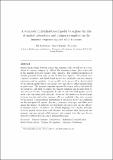Files in this item
A stochastic individual-based model to explore the role of spatial interactions and antigen recognition in the immune response against solid tumours
Item metadata
| dc.contributor.author | Macfarlane, F. R. | |
| dc.contributor.author | Chaplain, M. A. J. | |
| dc.contributor.author | Lorenzi, T. | |
| dc.date.accessioned | 2020-07-29T23:41:26Z | |
| dc.date.available | 2020-07-29T23:41:26Z | |
| dc.date.issued | 2019-11-07 | |
| dc.identifier | 260335481 | |
| dc.identifier | fb1d4e90-bda9-4e81-ad77-268773198ae6 | |
| dc.identifier | 85071898198 | |
| dc.identifier | 000487170600005 | |
| dc.identifier.citation | Macfarlane , F R , Chaplain , M A J & Lorenzi , T 2019 , ' A stochastic individual-based model to explore the role of spatial interactions and antigen recognition in the immune response against solid tumours ' , Journal of Theoretical Biology , vol. 480 , pp. 43-55 . https://doi.org/10.1016/j.jtbi.2019.07.019 | en |
| dc.identifier.issn | 0022-5193 | |
| dc.identifier.other | ORCID: /0000-0001-5727-2160/work/60196516 | |
| dc.identifier.other | ORCID: /0000-0003-2242-7745/work/60196605 | |
| dc.identifier.uri | https://hdl.handle.net/10023/20370 | |
| dc.description | FRM is funded by the Engineering and Physical Sciences Research Council (EPSRC). | en |
| dc.description.abstract | Spatial interactions between cancer and immune cells, as well as the recognition of tumour antigens by cells of the immune system, play a key role in the immune response against solid tumours. The existing mathematical models generally focus only on one of these key aspects. We present here a spatial stochastic individual-based model that explicitly captures antigen expression and recognition. In our model, each cancer cell is characterised by an antigen profile which can change over time due to either epimutations or mutations. The immune response against the cancer cells is initiated by the dendritic cells that recognise the tumour antigens and present them to the cytotoxic T cells. Consequently, T cells become activated against the tumour cells expressing such antigens. Moreover, the differences in movement between inactive and active immune cells are explicitly taken into account by the model. Computational simulations of our model clarify the conditions for the emergence of tumour clearance, dormancy or escape, and allow us to assess the impact of antigenic heterogeneity of cancer cells on the efficacy of immune action. Ultimately, our results highlight the complex interplay between spatial interactions and adaptive mechanisms that underpins the immune response against solid tumours, and suggest how this may be exploited to further develop cancer immunotherapies. | |
| dc.format.extent | 3451866 | |
| dc.language.iso | eng | |
| dc.relation.ispartof | Journal of Theoretical Biology | en |
| dc.subject | Tumour-immune competition | en |
| dc.subject | Individual-based models spatial interactions | en |
| dc.subject | Antigen recognition | en |
| dc.subject | Antigenic variations | en |
| dc.subject | QA Mathematics | en |
| dc.subject | QH301 Biology | en |
| dc.subject | QR180 Immunology | en |
| dc.subject | RC0254 Neoplasms. Tumors. Oncology (including Cancer) | en |
| dc.subject | NDAS | en |
| dc.subject | SDG 3 - Good Health and Well-being | en |
| dc.subject.lcc | QA | en |
| dc.subject.lcc | QH301 | en |
| dc.subject.lcc | QR180 | en |
| dc.subject.lcc | RC0254 | en |
| dc.title | A stochastic individual-based model to explore the role of spatial interactions and antigen recognition in the immune response against solid tumours | en |
| dc.type | Journal article | en |
| dc.contributor.sponsor | EPSRC | en |
| dc.contributor.institution | University of St Andrews. Applied Mathematics | en |
| dc.contributor.institution | University of St Andrews. School of Mathematics and Statistics | en |
| dc.identifier.doi | https://doi.org/10.1016/j.jtbi.2019.07.019 | |
| dc.description.status | Peer reviewed | en |
| dc.date.embargoedUntil | 2020-07-30 | |
| dc.identifier.grantnumber | EP/N014642/1 | en |
This item appears in the following Collection(s)
Items in the St Andrews Research Repository are protected by copyright, with all rights reserved, unless otherwise indicated.

